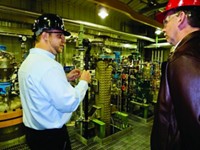Advertisement
Grab your lab coat. Let's get started
Welcome!
Welcome!
Create an account below to get 6 C&EN articles per month, receive newsletters and more - all free.
It seems this is your first time logging in online. Please enter the following information to continue.
As an ACS member you automatically get access to this site. All we need is few more details to create your reading experience.
Not you? Sign in with a different account.
Not you? Sign in with a different account.
ERROR 1
ERROR 1
ERROR 2
ERROR 2
ERROR 2
ERROR 2
ERROR 2
Password and Confirm password must match.
If you have an ACS member number, please enter it here so we can link this account to your membership. (optional)
ERROR 2
ACS values your privacy. By submitting your information, you are gaining access to C&EN and subscribing to our weekly newsletter. We use the information you provide to make your reading experience better, and we will never sell your data to third party members.
Materials
Thomas J. Stanley
The technology chief of SABIC Innovative Plastics says polymers still hold a lot of potential
by Alexander H. Tullo
August 24, 2009
| A version of this story appeared in
Volume 87, Issue 34
Thomas J. Stanley, vice president of technology for SABIC Innovative Plastics, concedes that there is some truth to the stereotype that chemical engineers are practical minded, whereas chemists tend to be academic.
“Engineers have more of an orientation toward how you leverage the chemistry to make an economical process and get efficient commercial results,” he says. “Chemists have more of an orientation toward exploiting the chemistry in a more sophisticated way. Both traits are important, and you have to have both competencies in your organization to be successful.”
Stanley, for his part, is a chemical engineer who earned a Ph.D. from the University of Pennsylvania. He joined General Electric in 1986 at its corporate research center in Niskayuna, N.Y., working on tungsten powders for light bulbs. “You can’t be more mainstream in General Electric than that,” he says.
He moved to GE Plastics, the predecessor of SABIC Innovative Plastics, in 1992, when he took on a project to develop blends of polyphenylene oxide (PPO) and polybutylene terephthalate for auto body panels. The idea was to improve on Noryl GTX, a polyamide/PPO blend that has dimensional stability problems owing to polyamide’s tendency to absorb moisture. The project didn’t move ahead. “It wasn’t better enough in that application for the customer to decide to switch over,” Stanley recalls.
Stanley took on positions of increasing responsibility at GE Plastics before transferring in 2002 to GE’s silicones business, where he served as general manager of technology. He returned to GE Plastics not long before Saudi Basic Industries Corp. (SABIC) purchased the business in 2007.
Stanley maintains that SABIC and the former GE Plastics have been a good fit. “We are very fortunate to have been bought by SABIC,” he says. “Here is a company that has historically been a commodity petrochemical company but recognizes its future has to be increasingly specialty. Our business really fit into the future of where SABIC wanted to take its business, and that’s a great place to be.”
GE, Stanley notes, had decided to focus its industrial units elsewhere, in areas such as water treatment and transportation. “GE was a great company. I loved working for GE, and I wouldn’t trade my experiences there for a minute. But as a materials company, GE’s future was minimal.”
Despite the plastics industry’s stereotype as a mature, low-growth sector, Stanley thinks it can still make meaningful technological progress in resin processing, formulation chemistry, and polymer science.
On the resin-processing front, the company is exploring new markets for its Ultem polyether imide, a high-heat engineering plastic. Seizing on Ultem’s flame retardancy and low flame-smoke toxicity, SABIC Innovative Plastics has been developing fiber, sheet, and foam applications. The fibers are being used in firefighter suits, and the foam and sheet are intended for thermoformed panels on aircraft interiors.
Stanley says the new owners are encouraging the plastics business to branch out. “GE Plastics was an injection-molding house,” he says. “In recent years, we started to look at where there are opportunities to leverage the base properties of our materials in applications that are beyond injection molding.”
The business’ LNP Engineering Polymers unit develops new compounding technologies, and Stanley is particularly excited about Stat-Kon TR, a compounded resin that contains a conductive additive. When a current is applied to the plastic, it heats up. As the plastic expands from the heat, the conductive particles move away from each other, causing the current to stop at a specified temperature. The company is targeting applications such as heated car seats, where one piece of plastic can do the work of thermocouples and other circuitry.
In polymer science, the company has been polymerizing new monomers with bisphenol A (BPA) to create novel polycarbonate copolymers. The first in the series was Lexan SLX, a polyester carbonate based on resorcinol arylates. With bonds that rearrange themselves when hit by ultraviolet light, the polymer effectively repairs itself from weathering. In the early 2000s, GE Plastics had aspirations of molding the polymer into auto body panels that would replace painted parts. Despite its fancy chemistry, the polymer never took off as GE had hoped.
Stanley says other copolymers have been more successful. Lexan EXL is a copolymer of BPA and a phenoxy-terminated siloxane, which imparts low-temperature ductility. Stanley describes a video of someone in a freezer hitting a mailbox made of the stuff with a sledgehammer, unable to break it. The company is marketing it for the housings of small electronic gadgets.
On the other end of the spectrum, the company has launched Lexan XHT, which has another phenoxy-capped monomer that allows the resin to withstand temperatures up to 200 ºC. It is also launching copolymers that offer scratch resistance and low flame-smoke toxicity.
Stanley says SABIC Innovative Plastics is taking a different approach to the new copolymers than it did with Lexan SLX. “Our biggest mistake, especially at GE Plastics, is that we tried to do too much ourselves. We tried too hard to be the expert in the entire value chain,” he says.
Now the emphasis is on partnerships with customers, and even manufacturers further down in the supply chain, as a way for Stanley’s chemists and chemical engineers to borrow expertise. This is something that the business’ new parent is encouraging. SABIC, he points out, has been involved in major petrochemical partnerships since its beginnings in the early 1980s. “SABIC does ventures and partnerships,” Stanley says. “It is something we will learn from, and I think it will be very beneficial.”






Join the conversation
Contact the reporter
Submit a Letter to the Editor for publication
Engage with us on Twitter